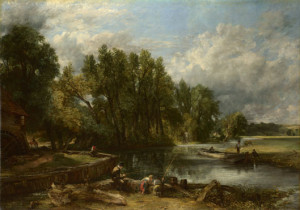PREVIOUS: TURNER – THE FIGHTING TEMERAIRE
John Constable: Stratford Mill: 1820
We think of Constable’s landscapes as classic images of the English countryside, almost ‘chocolate boxy’ they’ve been reproduced so often, but when they were painted they were thought of as radical and daring, every bit as innovative and untraditional as Turner.
This is Stratford Mill, one of six major paintings by Constable that show scenes from the River Stour in Suffolk, the most famous of which is probably the Hay Wain.
It’s a country scene. In the foreground there is an older man and a couple of children fishing, their rods leading our eye to the barge which is moored by the side of the river. That then leads us to a gate on the far side of the bank, and to the right of that through a gap in the trees we can see a house in the distance. Over on the left of the picture is Stratford Mill itself, the water gleaming on the mill wheel as it turns, and behind this a man has stopped his horse by the river for it to have a drink.
The line of trees goes off into the distance and we can see the wonderful Suffolk sky reflected in the river. The overall impression is of rest, with everything moving very slowly if at all. ‘Languid’ would be the word that comes to mind.
It’s a stylised and unreal version of the countryside of course. At the time this was painted, the actual countryside was a place of poverty and disruption caused by the agricultural and industrial revolution. Constable isn’t concerned with this reality – he’s trying to do is to get as realistic a version of nature as he could. The culture of the time was for artists to compose their pictures from their imaginations; Constable worked differently trying to capture what he saw, often by doing numerous full-scale oil sketches of scenes that later became finished works.
This was very different from the traditional landscape painting of the time. Here Constable brings in lots of actual detail rather than giving a stylised view – look at the range of colours that make up the grass and the trees. As well as greens, he’s used browns and yellows, and some of the leaves are touched with white and silver to bring out the effect of the light. At the time many found his greens too bright, and his use of white to show reflections on the water became known as “Constable’s Snow.”
Although we think of him as typically English, it took a long time for him to be accepted by the art establishment here – he was 52 before he was allowed to become a member of the Royal Academy – but his work was very respected in France and was a big influence on the Impressionists, particularly his attempt to capture nature in the moment. Our next artist is Monet, who we know admired Constable’s work when he was in London in 1870, so let’s see how the Impressionists developed landscape painting 50 years later.


